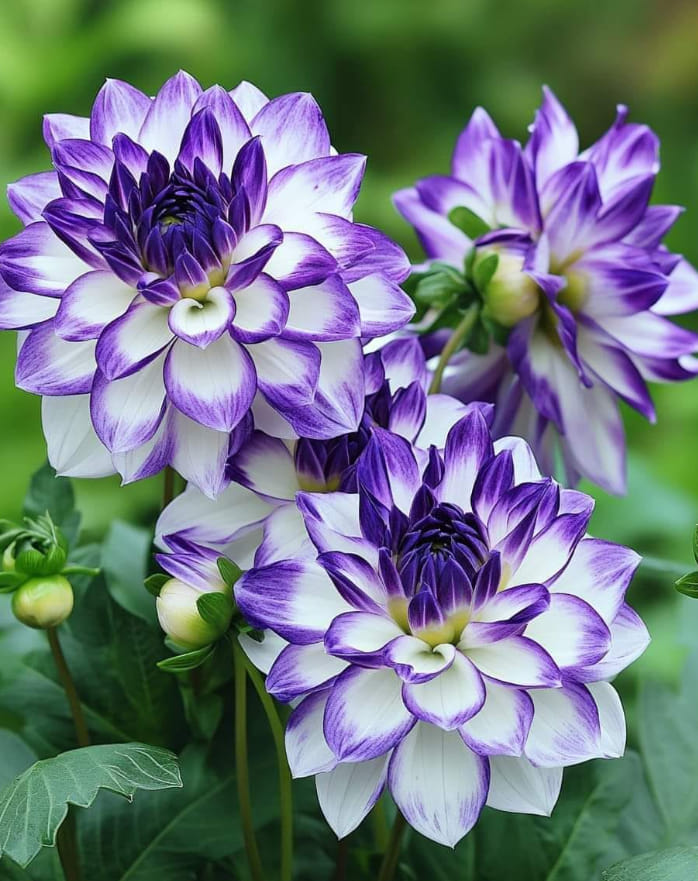The Dahlia is a stunning, vibrant flower known for its captivating blooms, which often feature intricate layers of colorful petals, such as white and purple, creating a mesmerizing and elegant display. Whether you’re looking to brighten up your garden beds or create beautiful floral arrangements, Dahlias are sure to make a lasting impression. Here’s a guide to help you care for these charming flowers and ensure they thrive.
Light Requirements
Dahlias require full sun to produce their best blooms. These flowers need plenty of sunlight to grow strong and healthy, and the more sunlight they receive, the more vibrant their flowers will be.
Ideal conditions: Choose a location where your Dahlia plants will get around 6-8 hours of direct sunlight each day. This can be a sunny garden bed or a space with abundant light exposure.
Avoid: Planting Dahlias in shaded areas, as they may not bloom as profusely and could become leggy with poor light conditions.
Watering Needs
Dahlias like consistently moist soil, but overwatering can lead to root rot. It’s important to find a balance and avoid letting the soil dry out completely.
Watering schedule: Keep the soil consistently moist but not soggy. Water deeply to ensure the roots get enough hydration, especially during dry spells or hot weather. However, make sure the soil has good drainage to avoid waterlogging.
Avoid: Watering too frequently, as soggy soil can lead to rot and other diseases. Use a well-draining soil mix to ensure that excess water can easily escape.
Soil and Potting
Dahlias thrive in well-draining, rich soil. They prefer soil that is both nutritious and loose, allowing for proper root growth and water drainage.
Ideal soil: Use a rich, well-draining soil that is amended with organic matter such as compost. The soil should hold moisture but not become compacted or waterlogged.
Avoid: Heavy clay or compacted soils that don’t drain well, as these can cause water to pool around the roots and lead to root rot.
Temperature and Humidity
Dahlias are generally comfortable in moderate temperatures and can handle a range of climates, though they tend to perform best in mild conditions.
Ideal temperature: Dahlias grow best in temperatures between 60-70°F (16-21°C). These cooler, moderate temperatures provide the optimal environment for their blooms.
Humidity: Moderate humidity levels are ideal. While Dahlias can tolerate a bit of moisture in the air, they don’t like overly humid conditions, which can promote fungal diseases.
Avoid: Frosty or extremely hot conditions, which can damage the plant. In areas with freezing winters, Dahlias should be dug up and stored indoors to protect them from the cold.
Fertilizing Your Dahlia
Dahlias are heavy feeders, so providing them with proper nutrition will encourage healthy growth and abundant blooms.
Fertilizing schedule: Apply a balanced, slow-release fertilizer every 2-4 weeks during the growing season, from spring to late summer. Look for a fertilizer that contains equal parts of nitrogen, phosphorus, and potassium.
Avoid: Over-fertilizing with high-nitrogen fertilizers, as this can encourage leaf growth at the expense of flowers.
Care Tips for Healthy Dahlias
Deadheading: To encourage continuous blooming, remove faded or dead flowers (a process known as deadheading). This helps the plant focus its energy on producing new blooms.
Staking: Tall Dahlia varieties may require staking to keep their flowers upright. Use plant supports to prevent heavy blooms from toppling over, especially on windy days.
Mulching: Add a layer of mulch around the base of the plant to help retain moisture in the soil and keep the roots cool during hot weather.
Dividing: To keep your Dahlias healthy and encourage bigger blooms, divide the tubers every few years. This also prevents overcrowding and keeps the plants from becoming too root-bound.
Common Issues and Solutions
Yellowing Leaves: If the leaves turn yellow, it may indicate overwatering or poor drainage. Make sure the soil drains well, and adjust your watering schedule if necessary.
Pests: Dahlia plants can be susceptible to pests such as aphids, slugs, and spider mites. Regularly inspect the plants and use natural pest control methods like insecticidal soap or neem oil if needed.
Powdery Mildew: If you notice white, powdery spots on the leaves, this may be a sign of powdery mildew. To prevent this fungal issue, water the plants at the base, avoid overhead watering, and ensure good air circulation around the plants.
Conclusion
The Dahlia (Dahlia spp.) is an elegant and stunning flower that brings a burst of color and sophistication to any garden or floral arrangement. By providing your Dahlias with full sun, consistently moist soil, a well-draining potting mix, and regular fertilization, you’ll enjoy vibrant blooms all season long. Whether you’re looking to add height to your garden bed or create beautiful bouquets, Dahlias are the perfect choice for creating a captivating display of natural beauty.
More Article You Might Like
-
Texas Toast Sloppy Joes: The Crunchy, Cheesy Upgrade You Didn’t Know You Needed
There’s something timeless about sloppy joes. For generations, this saucy, savory, and slightly sweet ground beef sandwich has been a go-to comfort food in American kitchens. It’s quick, filling, and family-friendly—perfect for busy weeknights. But what if we told you there’s a way to take this classic dish up a notch? Enter the Texas Toast…
-
Classic Pig Pickin’ Cake
When it comes to Southern desserts, few sweets shine as brightly as the Classic Pig Pickin’ Cake. This nostalgic cake, sometimes called a “Mandarin Orange Cake,” has roots deep in Southern tradition. It gets its playful name from its frequent appearance at pig pickin’s—Southern-style barbecue gatherings where communities come together to enjoy slow-cooked pork, sides,…
-
Lemon Garlic Butter Chicken with Creamy Parmesan Pasta
There’s something irresistible about the combination of tender, golden-browned chicken paired with a creamy pasta coated in Parmesan cheese. Add the brightness of lemon, the depth of garlic, and the richness of butter, and you have a recipe that feels indulgent yet approachable enough for a weeknight dinner. Lemon Garlic Butter Chicken with Creamy Parmesan…



